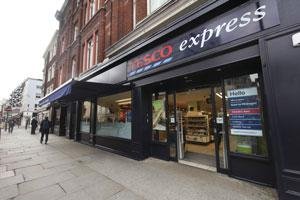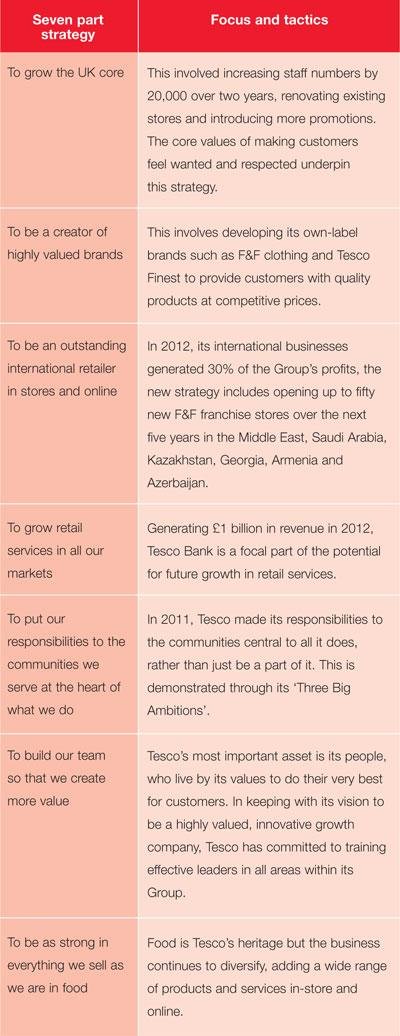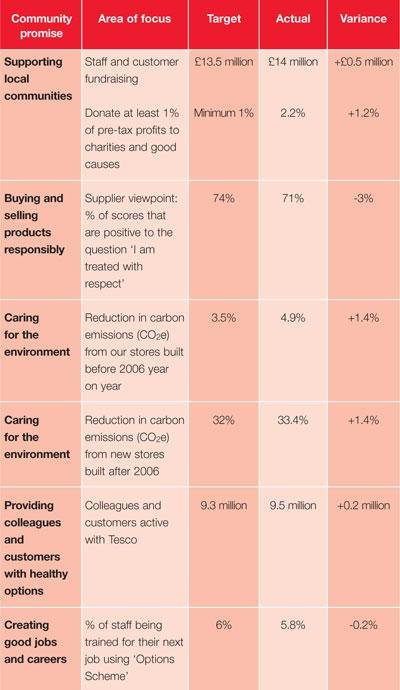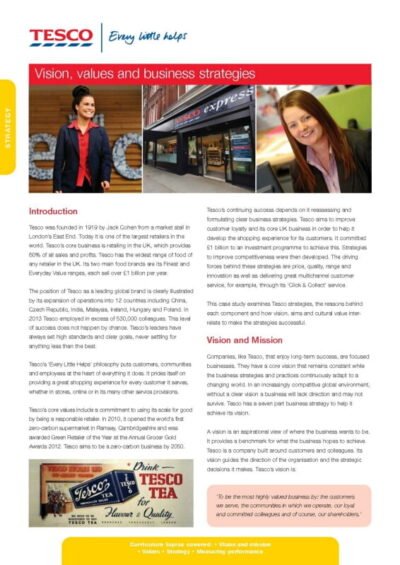
Tesco was founded in 1919 by Jack Cohen from a market stall in London’s East End. Today it is one of the largest retailers in the world. Tesco’s core business is retailing in the UK, which provides 60% of all sales and profits. Tesco has the widest range of food of any retailer in the UK. Its two main food brands are its Finest and Everyday Value ranges, each selling over £1 billion per year.
The position of Tesco as a leading global brand is clearly illustrated by its expansion of operations into 12 countries including China, the Czech Republic, India, Malaysia, Ireland, Hungary and Poland. In 2013 Tesco employed in excess of 530,000 colleagues. This level of success does not happen by chance. Tesco’s leaders have always set high standards and clear goals, never settling for anything less than the best.
Tesco’s ‘Every Little Helps’ philosophy puts customers, communities and employees at the heart of everything it does. It prides itself on providing a great shopping experience for every customer it serves, whether in stores, online or in its many other service provisions.
Core values

Tesco’s core values include a commitment to using its scale for good by being a responsible retailer. In 2010, it opened the world’s first zero-carbon supermarket in Ramsey, Cambridgeshire and was awarded Green Retailer of the Year at the Annual Grocer Gold Awards 2012. Tesco aims to be a zero-carbon business by 2050.
Tesco’s continuing success depends on it reassessing and formulating clear business strategies. Tesco aims to improve customer loyalty and its core UK business in order to help it develop the shopping experience for its customers. It committed £1 billion to an investment programme to achieve this. Strategies to improve competitiveness were then developed. The driving forces behind these strategies are price, quality, range and innovation as well as delivering great multichannel customer service, for example, through its ‘Click & Collect’ service.
This case study examines Tesco’s strategies, the reasons behind each component and how vision, aims and cultural values interrelate to make the strategies successful.
Vision and mission

Companies, like Tesco, that enjoy long-term success, are focused businesses. They have a core vision that remains constant while the business strategies and practices continuously adapt to a changing world. In an increasingly competitive global environment, without a clear vision, a business will lack direction and may not survive. Tesco has a seven part business strategy to help it achieve its vision.
A vision is an aspirational view of where the business wants to be. It provides a benchmark for what the business hopes to achieve. Tesco is a company built around customers and colleagues. Its vision guides the direction of the organisation and the strategic decisions it makes. Tesco’s vision is:
‘To be the most highly valued business by: the customers we serve, the communities in which we operate, our loyal and committed colleagues and of course, our shareholders.’
Tesco’s vision has five elements
Tesco’s vision has five elements which describe the sort of company it aspires to be. These are to be:
- wanted and needed around the world
- a growing business, full of opportunities
- modern, innovative and full of ideas
- winners locally whilst applying our skills globally
- inspiring, earning trust and loyalty from customers, our colleagues and communities.
The vision, mission statement and goals are interrelated and state what an organisation is seeking to achieve whereas the strategies and tactics show how it will achieve them. Tesco’s core purpose (mission) is simple:
‘We make what matters better, together.’

Once aims are established, functional areas within a business then devise department-based strategies to ensure goals are achieved. The vision drives the business and the values are embedded throughout the strategic planning process.
Whilst a vision outlines the aspirations of senior managers, a mission statement is a general expression of the overall purpose of the business. It communicates the goals of a company to all stakeholders. The vision should inspire all stakeholders and motivate employees towards achieving its stated objectives. If well prepared, it should convince customers, suppliers and external stakeholders of its sincerity and commitment to them.
Tesco’s management recognises the key role that its mission, vision and strategies play in its success and use a range of key performance indicators (KPIs) to monitor and evaluate its performance. These are explored in detail later in the case.
Values
Whilst a vision is important, without values a business such as Tesco would struggle to remain competitive. Tesco’s values are:
- No one tries harder for customers.
- We treat everyone how we like to be treated.
- We use our scale for good.
Tesco’s values are vital to its success, as shown in the quote below from Group Chief Executive Officer (CEO) Philip Clarke:
‘The Tesco values are embedded in the way we do business at every level. Our values let our people know what kind of business they are working for and let our customers know what they can expect from us.’

Tesco is a community-focused global business. Corporate Social Responsibility (CSR) is at the heart of its operations. This commitment is referred to as ‘Tesco in Society’. In the competitive retailing world, Tesco’s success relies on its values. They are not just a list of ‘good attitudes’ but the means to ongoing success.
Tesco’s approach to working with communities helps it stand out from its rivals. Its commitment to using its scale for good is demonstrated by Tesco’s ‘Three Big Ambitions’:
- To create new opportunities for millions of young people around the world.
- To improve health and through this help tackle the global obesity crisis.
- To lead in reducing food waste globally.
These are underpinned by what Tesco calls ‘The Essentials’:
- We trade responsibly.
- We are reducing our impact on the environment.
- We are a great employer.
- We support our local communities.
Philip Clarke summarises Tesco’s commitment to ‘living’ these values in the following statement:
‘Tesco is an environment based on trust and respect…If customers like what we offer, they are more likely to come back and shop with us again. If the Tesco team find what we do rewarding, they are more likely to go that extra mile to help our customers. By living the values we create a good place to work where great service is delivered.’
These values drive everything Tesco does at every level and help make it different from its competitors.
Strategy

A strategy is a plan which sets out how a business deploys its resources to achieve its goals. The company’s values set the tone for the decision-making process. In May 2011, Tesco committed £1 billion in capital and revenue investment to improve the shopping trip for customers. It set out a seven part strategy designed to achieve its goals of being highly valued by customers and enjoying strong long-term growth. The table shows the main elements of this strategy.
Monitoring and evaluating performance

Strategy, vision, values, aims and objectives are meaningless if their impact is not monitored and evaluated. Tesco uses a range of methods to collect data and evaluate progress against targets. It uses its Clubcard scheme, along with telephone based research and an online panel of customers, to determine what customers want and how satisfied they are with Tesco’s performance.
Its Executive Committee assesses the progress of large-scale strategies. All of its business units have ‘stretching targets’ which are aspirational targets for certain KPIs. The performance of all business units is monitored continually and reported monthly to the board of directors. The following table shows how Tesco monitored its performance against targets using KPIs for the 2012/13 period.
These KPIs are used to assess current performance, make comparisons with previous performance and help managers respond when targets are not being met. For instance, following the investigation, an explanation for narrowly missing the staff training target was given:
‘Although narrowly missing this target, Tesco have also heavily invested in our colleagues in the UK this year through our ‘Building a Better Tesco’ plan. More than 250,000 colleagues in-store have received customer service training, with additional technical training for 36,000 colleagues.’

Monitoring healthy options for customers and colleagues supports Tesco’s commitment to helping employees and customers make healthy choices and lead healthier lives. In a revolutionary scheme, using data from its Tesco Clubcard, it has developed a ‘healthy little differences’ tracker. This measures the health profile of a ‘typical’ shop by measuring the nutritional value of what customers buy. This will be used to set targets to improve customers’ health by comparing how the profiles vary across different groups in society and how healthy initiatives impact customers’ shopping over time.
Conclusion

Tesco is one of the largest retailers in the world. This success has not come about by chance but is the result of effective leadership and management. The setting of a clear vision is central to Tesco’s success, supported by a commitment to establishing and monitoring specific objectives and devising strategies to ensure these are achieved. All aspects of the business are regularly monitored and, when necessary, plans are adapted to ensure targets are ultimately met. At the heart of all Tesco does is a commitment to being a responsible retailer. This is demonstrated through its focus on its ‘Three Big Ambitions’ and ‘The Essentials’ to show how it is using its scale for good. Every decision taken considers these areas to ensure customers, communities, suppliers and staff are treated fairly and with respect. Tesco’s values underpin all that Tesco does and, in turn, keeps customers satisfied with their shopping experience and loyal to the brand.
 Vision, values and business strategies (PDF)
Vision, values and business strategies (PDF) 